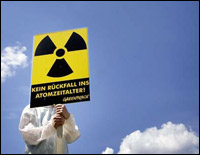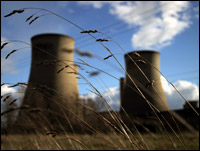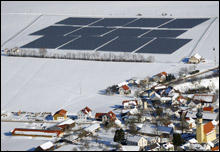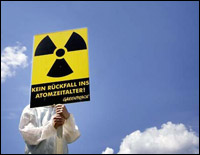For a people as addicted to order as the Germans, this country is floundering in uncertainty. The economy has sputtered to a post-World War II record 5 million unemployed. Chancellor Gerhard Schröder’s exhausted left-of-center coalition is close to coughing up the fall elections to conservatives. And soccer fans aren’t even sure if their team can defend the country’s pride when it hosts the World Cup next summer.

Protesters have been up in arms.
Photo: Rosenthal/Greenpeace.
About the only thing most Germans are sure about right now is the dire need to abandon nuclear power, evidenced by the “Switch Off and Rethink” mantra stamped on billboards and in newspapers, buzzing from television sets, and crossing people’s lips throughout the nation. And tough policies enacted by the red-green government have laid an incredible groundwork for that move — not just for Europe’s wealthiest nation to become nuclear-free in the next 15 years, but for renewable-energy suppliers to double their output to provide one-fifth of Germany’s power within the same period. By mid-century, the country expects to derive more than half of its power from renewables.
Pulling the plug on nuclear might be easier said than done if the atomic-friendly Christian Democrats take power in September. Many here anticipate that shift, and fear that the new leaders will try to roll back a half decade of anti-nuclear legislation. If that is the case, though, they’ll be waging an uphill battle. One year after Germany hosted the first-ever international conference on renewable fuels, it’s safe to say the country is in the midst of an energy revolution.
Two Down, Seventeen to Go
Five years ago, the government negotiated a Nuclear Exit Law with the power industry, requiring all 19 of its atomic power stations to shut down by 2020. No easy task for a country of 82 million, which currently relies on nuclear for 30 percent of its power. But it’s happening: in May, authorities began closing down Obrigheim, a plant near the Rhine River in the area south of Frankfurt, making it the second reactor to go off-line.
With a three-part energy mix set to take nuclear’s place — a short-term increase in cleaner coal- and gas-powered plants, an increase in renewable-fuels production, and an emphasis on domestic energy efficiency — economists, engineers, and energy specialists consider Germany’s decision to phase out nuclear a no-brainer. The strategy not only avoids further costs to human health, the climate, and the economy, they say, it makes sense for other key reasons.
“The investment in nuclear plants has been paid off,” says Michael Schroeren, a spokesperson for the German Environment Ministry. “If you prolong their operating time, the companies will simply avoid making the new investments in renewables.” Taking a starker angle, physicist Wolfgang Neumann of Intac, a waste-management organization based in Hannover, argues that “the risk is too great for a terrible accident” on the scale of Chernobyl. Finally, Germany should “get rid of nuclear as fast as possible because, at the moment, there is no solution for the waste,” warns Peter Hennicke, president of the Wuppertal Institute for Climate, Environment, and Energy.

Waste, want not.
In fact, the issue of waste is burning bright. Germany, engaged since the 1980s in one-way “nuclear tourism” to France and England — where spent fuel was processed and temporarily stored, kept out of sight and out of mind — enacted a ban on nuclear-waste exports earlier this year, as part of the exit agreement. The country must now figure out what to do with thousands of tons of hot radioactive fuel it can no longer get rid of, and which needs 30 to 40 years of cooling before it can be placed in permanent storage.
Between now and 2020, when the last plant is scheduled to close, Germany’s nuclear-power stations expect to produce about 6,000 additional tons of spent fuel. Were the plants’ lifetimes extended until 2040, as the conservative Christian Democrats have hinted at proposing should they triumph in September, the amount of unsecured waste could reach 10,000 tons. Thus far, Germany has failed to find a safe place to store this waste; in 2000, the government slapped a multi-year moratorium on investigations into Gorleben, a salt mine in the north of the country touted as a solution by nuclear engineers but considered insecure by others. Now the nuclear-power companies themselves are responsible for temporarily storing it. They’ll stash it at their retired plants, potentially posing a serious risk of accidents or terrorism.
Another complication in the phaseout is the pollution that will be caused by increased fossil-fuel burning, with coal and natural gas used as “bridging fuels” while renewables gear up. Coal already supplies 50 percent of Germany’s power; natural gas is responsible for nearly 10 percent. In the next 15 years, both will increase. However, some of the big players are making smart proposals — like Vattenfall Utility, which has promised to invest in cleaner coal-powered plants over the next decade.
In recent polls, 80 percent of Germans have voiced support for bringing an end to atomic energy. Now the phaseout’s main resistance is coming from Germany’s four main power producers, who control more than 80 percent of the energy market and all of the nuclear production. They cringe at the prospect of small renewables producers getting a chunk of the pie. But that’s the tack this country is taking — straight into the wind, and with remarkable speed and success, due to another big-time policy move: the Renewable Energy Sources Act.
Try It, You Might Like It
In the last five years, thanks to this singular piece of Green legislation, Germany has doubled its production of renewable fuels like wind, solar, geothermal, hydro, and biomass, which now comprise more than 10 percent of the total energy supply. Using essential free-market principles, the country has begun a radical re-mixing of its energy system which, if things go as planned or better, means Germany will be running on at least 65 percent renewables by mid-century.

Solar grows in a Bavarian field.
Photo: PowerLight Corporation.
Already, Germany is the leading producer of wind power, controlling 40 percent of the global market and employing 35,000 people in an industry that has seen production costs plummet. The country is second behind Japan in solar-energy production, hosting massive facilities in sun-filled Bavaria, while boosting ties to growing solar-power production markets in places like Spain and the Middle East. In terms of plain workforce numbers, alternative-energy outfits in Germany employ around 130,000, three times as many as nuclear.
And the encouragement keeps on coming. A key feature of the energy act is its “feed-in tariff,” which stipulates a fixed, higher price paid by transmission companies to producers of renewable fuels for every kilowatt-hour of clean energy they feed into the grid. The extra cost is then tacked onto consumers’ monthly power bills. The genius of the subsidy is that it forces consumers, not companies or the government, to foot the direct extra cost of producing renewable energy — but at a price they hardly feel.
For example, the average German household today pays an extra 0.4 cents per kilowatt-hour of electricity it receives from wind, adding a modest total of about $17 to the yearly power bill. By 2020, renewables are expected to power 20 percent of the country, and the consumer household tax is likely to rise one cent per kilowatt-hour or less — a cost that economists say will hardly be felt, thanks to improvements in energy use and efficiency. (Demographic changes could also reduce energy needs in Germany, as the population is expected to drop as much as 15 percent by 2050.)
This ambitious plan for cutting energy use reflects the last challenge Germany faces to successfully rid itself of nuclear. The government, along with the power and appliance industries, must work hard to convince consumers to pay a slightly higher price now for new, energy-saving goods like more-efficient refrigerators, washing machines, computers, and the rest, in order to achieve 40 percent domestic energy (and cost) savings in the next 20 to 50 years. Small efficiency improvements in household appliances alone could save up to 2,000 megawatts per year nationwide, says the Wuppertal Institute — an amount equivalent to the annual output of two large nuclear plants.
All Aboard
It’s going to take more than Germany to raise the market roof on renewable technologies. The Intergovernmental Panel on Climate Change has said that global emissions need to be cut 70 percent just to keep the climate stable. Which is the kind of argument that makes President Bush’s stance at the recent G8 summit in Scotland all the more reviling: how long can the United States remain a consumer of one-quarter of the world’s energy and responsible for one-quarter of its CO2 output while continuing to deny that addressing climate change requires drastic and immediate energy-policy shifts?
Don’t ask Germans (or other Europeans, for that matter) to comment on America’s energy position. They’re fed up, for a lot of good reasons. But whether the U.S. changes course or not, leaders like Jürgen Tritten, Germany’s environment minister, are holding to a pledge that if the European Union adopts 30 percent cuts in carbon emissions by 2020, Germany will adopt 40 percent cuts. (Current E.U. targets of 15 to 30 percent cuts for that period have not yet been written into law.) And while the binding Kyoto agreement requires countries to cut emissions by 8 percent from 1990 levels by 2012, Germany has already cut its levels by 19 percent. Call it Green one-upmanship; the goal, says Tritten, is to continue “making Germany the world leader in alternative energy and in taking action against global warming.”
If the Christian Democratic Union, led by a scowling, Thatcher-esque Angela Merkel, rides the national mood of discontent over unemployment and policy gridlock to power this autumn, the likelihood is that they will seek not to completely reverse Germany’s nuclear phaseout, but to prolong the lifespan of its remaining reactors. What is certain to Lutz Metz, an energy-policy professor at Berlin’s Freie University, is that the CDU will bring “very naive policies” to the table. “The Christian Democrats want the security of power plants to define the length of their running time,” Metz says. “That means more security checks of existing plants, rather than changing the structure and phasing out plant use entirely.” By convincing Germans that their remaining atomic plants operate under safe conditions, conservatives may try to keep the nuclear industry in business as long as possible — if not preventing, then at least delaying, its demise.
But as fuel prices continue to rise, in a sense it doesn’t much matter which political party takes office in September, because Germany’s development of renewables will become an economic, not just an environmental, priority. To come back to Hennicke of the Wuppertal Institute: “A big electricity producer is not interested in the source of his electricity. He is interested in the source of his profit. Whether it comes from nuclear or wind or coal doesn’t matter, as long as the profit rate is high enough.”
And that is the secret behind Germany’s energy revolution: free-market thinking holds it all together. With the government requiring consumers to pay more for clean energy that will save them money in the long run, the renewables industry got the bump it needed. Unlike in the U.S., where scientists, economists, environmental pundits, and even an occasional brave politician have been talking about the renewables revolution for years without making much progress, in Germany that transition is visibly, and heatedly, under way.
No matter what happens in the next election, the Greens have made good use of their seven years in office alongside the Social Democratic Party. Already, China has adopted elements of the Renewable Energy Sources Act to fit its own power-scheme model. In November, an international renewables conference in Beijing will explore strategies that China and other developing countries might use to accelerate into an alternative-energy future. The world’s “developed” countries would do well to take note.



